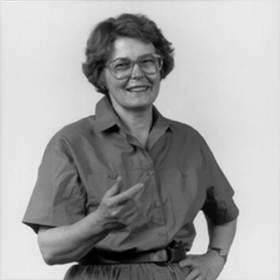
Margaret B.
Davis
My research concerns long-term forest dynamics in an old-growth forest in northern Michigan. Forest communities at the Sylvania Wilderness are a mosaic of stands dominated either by hemlock or by sugar maple; my students and I are trying to find out how the mosaic formed and how it is maintained. To answer these questions we need to study present day ecological processes, such as nutrient cycling, dispersal of seeds and the response of the forest to windstorms and fires. Very long-term information is provided by fossil pollen in the numerous small swales and hollows that occur throughout the forest. These small sites capture pollen from within a few tens of meters, enabling us to follow the history of individual forest stands. Even small hollows 100 m apart provide very different records. This method allows us to trace the pattern of differential invasion of forest stands by hemlock 3000 years ago, and to follow the changes in disturbance regimes that accompany forest change.
Research at Sylvania is particularly satisfying because it combines modern process studies in an old-growth, undisturbed forest wilderness with retrospective studies using fossil pollen and other indicators of past environment. The fine spatial scale on which we are working makes the result more interesting to ecologists and to foresters than the regional scale studies that I pursued before beginning to work in Sylvania 10 years ago.
Three of my current graduate students are actively involved in research at Sylvania and the surrounding region, while a fourth is studying the role of Lake Superior in the climate history of the Upper Peninsula, using paleoecology and modeling. Yet another student has initiated research on the vegetation and climatic history of the Hawaiian Islands -- a fascinating project that may shed light on the Quaternary climatic history of the tropics in general.
The history of the environment is actively studied by meteorologists, geographers, geologists and archeologists, with whom we have continuing contact through the NSF-funded Research Training Group in Paleorecords of Global Change (a training grant with a Steering Committee drawn from several departments), and the Quaternary Paleoecology Graduate Minor. Minnesota has a long tradition of interdisciplinary research and graduate training.
Davis, M.B., T.E. Parshall and J. B. Ferrari. 1996. Landscape heterogeneity of hemlock-hardwood forest in northern Michigan. Northeastern Old-Growth Forest, ed. Mary Byrd Davis, Island Press pp. 291-304.
Davis, M.B. and S. Sugita. 1995. Reevaluating the pollen record of Holocene tree migration. In Past and future environmental changes: the spatial and evolutionary responses of terrestrial biota. Proceedings of a NATO workshop. B. Huntley, ed., Elsevier, London. in press.
Davis, M.B., S. Sugita, R.R.Calcote, J.B. Ferrari, and L.E. Frelich. 1994. Historical development of alternate communities in a hemlock-hardwood forest in northern Michigan, USA. p. 19-39 in Large-scale Ecology and Conservation Biology. R. May, N. Webb, and P. Edwards, eds., Blackwell, Oxford.
Frelich, L.E., R.R.Calcote, M.B. Davis, and J. Pastor. 1993. Patch formation and maintenance in an old-growth hemlock-hardwood forest. Ecology 74(2): 513-527.
Davis, M.B., S. Sugita, R.R.Calcote, and L.E. Frelich. 1992. Effects of invasion by Tsuga canadensis on a North American forest ecosystem. pp. 34-44 in Response of Forest Ecosystems to Environmental Changes. A.Teller, P. Mathy, and J.N.R. Jefferes, eds., Elsevier Applied Science, London.
Davis, M.B., M.W.Schwartz, and K.D.Woods. 1991. Detecting a species limit from fossil pollen in sediment. Jour. Biogeography 128: 653-668.